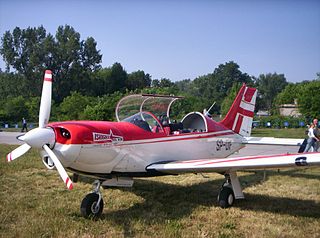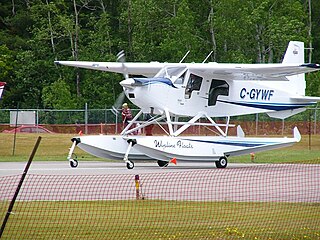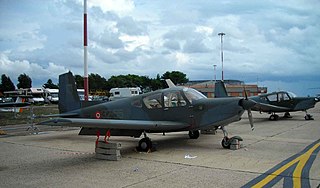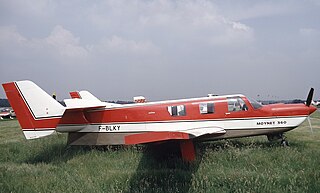
The IMCO CallAir A-9 is a small agricultural aircraft that first flew in 1962, a development of the company's previous successful crop-dusters. It is typical of aircraft of its type - a single-seat aircraft with a low wing incorporating spraying gear.

The Piper PA-24 Comanche is an American four-seat or six-seat, low-wing, all-metal, light aircraft of semimonocoque construction with tricycle retractable landing gear. Piper Aircraft designed and developed the Comanche, which first flew on May 24, 1956. Together with the PA-30 and PA-39 Twin Comanches, it made up the core of the Piper Aircraft lineup until the production lines for both aircraft were destroyed in the 1972 Lock Haven flood.

The CAP Aviation CAP-23x family is a family of aircraft designed for competition aerobatics. The CAP 230 airframe was a direct development of the CAP 21 competition single seater strengthened to cope with a 300 hp (220 kW) 6-cylinder Lycoming AEIO-540 engine instead of the 200 hp (150 kW) original 4-cylinder Lycoming AEIO-360.

The Piper PA-31 Navajo is a family of cabin-class, twin-engined aircraft designed and built by Piper Aircraft for the general aviation market, most using Lycoming engines. It was also license-built in a number of Latin American countries. Targeted at small-scale cargo and feeder liner operations and the corporate market, the aircraft was a success. It continues to prove a popular choice, but due to greatly decreased demand across the general aviation sector in the 1980s, production of the PA-31 ceased in 1984.

The Beechcraft Queen Air is a twin-engined light aircraft produced by Beechcraft in several versions from 1960 to 1978. Based upon the Twin Bonanza, with which it shared key components such as wings, engines, and tail surfaces, but featuring a larger fuselage, it served as the basis for the highly successful King Air series of turboprop aircraft. It is often used as a private aircraft, a utility, or a small commuter airliner. Production ran for 17 years.

PZL M26 Iskierka or M26 Airwolf is a Polish trainer and aerobatic aircraft, designed at WSK PZL-Mielec.

The Found FBA-2 is a 1960s Canadian four/five-seat cabin monoplane that was produced by Found Aircraft.

The SIAI-Marchetti S.205 is an Italian four-seat, single-engine, light airplane, manufactured by SIAI-Marchetti. The S.205 made its maiden flight in 1965. The Italian Air Force employs a version called S.208.

The type designation Dornier Do 28 comprises two different twin-engine STOL utility aircraft, manufactured by Dornier Flugzeugbau GmbH. Most of them served with the German Air Force and Marineflieger and other air forces around the world in the communications and utility role. The Do 28 series consists of the fundamentally different Do 28 A/B (1959) and Do 28 D Skyservant (1966).

The Piper Aerostar is an American twin-engined propeller-driven executive or light transport aircraft, designed by Ted R. Smith. It was originally built by Ted Smith Aircraft Company, which after 1978 became part of the Piper Aircraft Corporation.

The UTVA-66 is a STOL aircraft, which was produced in the former Yugoslavia. It was developed from the UTVA-60 and first flew 1966.

The Ruschmeyer R 90-230 RG is a four-seat light aircraft designed and produced in Germany in the late 1980s and early 1990s.
The UTVA-60 is a Yugoslavian light aircraft of the 1960s. First flying in 1959, it was built by UTVA for both the Yugoslavian armed forces and for civilian use.

The Moynet M 360 Jupiter was a small executive transport built in France in the 1960s. It had an unusual twin-push-pull, single-fuselage configuration. Two prototypes were produced, the second with more power and seating, but no sales resulted.
The Jurca MJ-51 Sperocco is a plans-built two-seat tandem aerobatic aircraft derived from the Jurca MJ-5 Sirocco.

The Glasair Sportsman 2+2 is a single-engine, high wing, strut-braced, four seat kit aircraft, developed by the Glasair Aviation company.

The Team Rocket F1 Rocket is a two-seat sport plane formerly built in Czech Republic and marketed as a kit for amateur construction by Team Rocket of Texas, United States. As of April 2017, the aircraft is being produced in the U.S. under license from Team Rocket by Frazier Aviation of Indiana.

The AeroVolga LA-8 is an 8-seat amphibious aircraft designed and built in Russia. First flown in 2004, about six had been sold by mid-2012.
The Ultimate 10-200 is a Canadian homebuilt aerobatic biplane that was designed produced by Streamline Welding of Hamilton, Ontario, introduced in the 1990s. When it was available the aircraft was supplied as a kit or in the form of plans for amateur construction.
The Whisper X350 Generation II is a South African amateur-built aircraft, designed in 2015 and produced by Whisper Aircraft of Mossel Bay. The aircraft was developed from the 2004-designed Whisper Aircraft Whisper motorglider. The X350 Generation II is supplied as a kit for amateur construction.
















